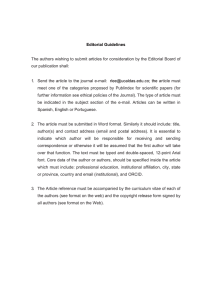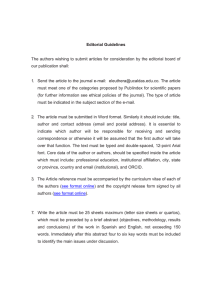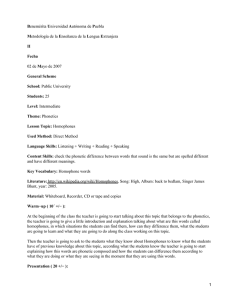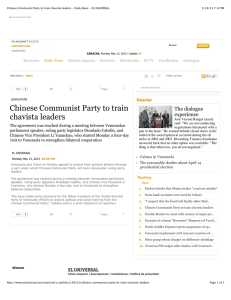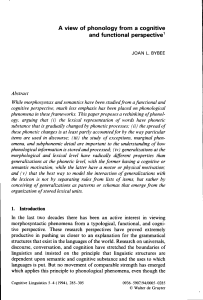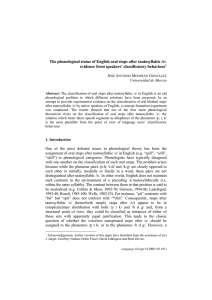SOUND CLUES IN MANDARIN CHARACTER
Anuncio
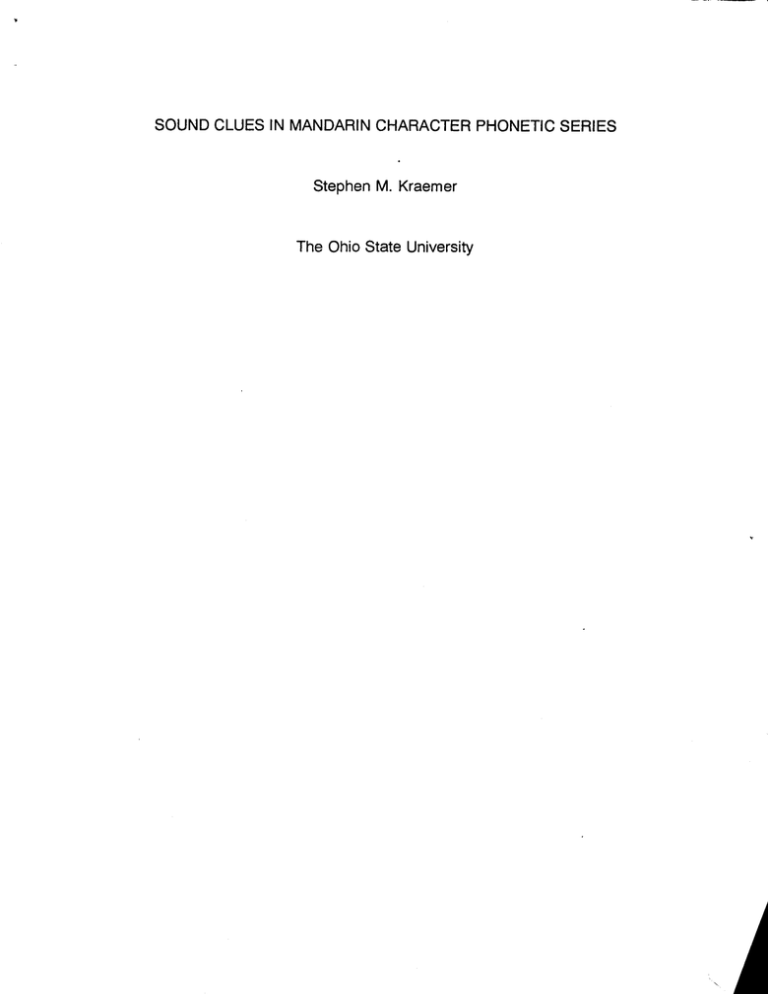
SOUND CLUES IN MANDARIN CHARACTER PHONETIC SERIES Stephen M . Kraemer The Ohio State University Copyright 1991 Stephen M. Kraemer 1 At a time when China is growing in international importance, the Chinese language is receiving considerable attention from scholars and educators worldwide. In the United States, Chinese is taught as a foreign language in a number of colleges, universities, and secondary schools . Since World War II, the teaching of Chinese has been influenced by the development of intensive language programs, the audiolingual method, situationalized and contextualized learning, and computerized instruction Chinese. still Despite these advances, however, the American student of faces the burden of having to learn one of the world's most complex writing systems. In order to learn written Chinese, he or she must master several thousand nonalphabetic symbols, or characters, most often by rote memorization. Although the history of the Chinese writing system is long and complex, certain major principles used in the formation of characters can be identified . In classical Chinese teachings, based on the famous Shuo wen jie zi dictionary compiled by Xu Shen (2nd century A.D.), the characters are divided into Six Classes . The first four of these pertain to the formation of the characters and will be outlined here. The first category contains the "pictographs" or drawings of common objects, which comprise [] some of the for 'sun' and earliest known characters . Examples of these are the characters for 'moon' . The second category contains the "ideographs" or characters used to express some basic ideas or concepts . Examples of these include the characters — 'one' and [] 'two', and [] `above', and T 'below' (Newnham 1971 :35-36) . When two simple characters are placed together to form a more complex notion, the third group of characters called logical aggregates" (Wieger 1965:10) is established . Examples of this group are the characters [] 'good', composed of [] 'woman' on the left and-f 'child' on the right (Newnham 1971 :36); 2 and [] 'to cast lots', composed of [] `mouth' on the bottom and 'divination' on top (Wieger 1965 :10). The fourth group of characters contains the "phonetic compounds" . These characters consist of two parts : (1) the "signific", which indicates the meaning of the character, and (2) the "phonetic", which indicates how the character should be pronounced. For example, in the character [] mo' 'foam', the signific [] `water' on the left suggests the meaning, while the phonetic , a character pronounced ma by itself, lends the pronunciation . If this process of forming phonetic compounds is continued, a phonetic series of characters can be formed, where all the characters in a series share a common phonetic element, but have different significs . For example, if the signific ) `fire' is added to the phonetic * mo', the phonetic compound [] mo, `a dull fire' is formed . If the signific 'grain' is added to the phonetic mo, the compound [] mo, 'fodder' is formed (Wieger 1965:429). The phonetic mo is also a character by itself, and is included as the first member of the series. If all characters that share a common phonetic element have the same pronunciation, including tone, the resulting phonetic series can be called "Totally Perfect" (Kraemer 1980) . An example of such a Totally Perfect phonetic series is the zhang series, given in Figure 1. Recognizing that the sound and meaning clues inherent in phonetic compound characters may be of value to students learning Mandarin, Astor (1970 :61-62 ) identifies 63 Totally Perfect series out of total of 858 phonetic series compiled by L. Wieger in his book Chinese Characters . For seven of these 63, Astor devises actual teaching lessons to be used by the student for self-study . He also identifies some 50 3 (The Phonetic) zhang A measure (ten Chinese feet) . A term of respect. zhang Weapons ; to fight. zhang A staff, a stick ; to beat. Figure 1 . The zhang phonetic series, from L . Wieger, S .J ., Chinese Characters, (New York, Paragon ; Dover, 1965), p . 399. 4 near-Totally Perfect phonetic series, where all characters in a series have the same pronunciation, except one (Astor 1970 :63-64). If all phonetic series in Mandarin were indeed Totally Perfect, i .e ., if written phonetic elements indicated a completely identical pronunciation in all characters that shared those elements, then written Chinese might be more amenable to the learner . This, however, is not the case . Characters that comprise the majority of phonetic series in Mandarin Chinese are not identical in their pronunciations, and it is this departure from the phonological ideal that helps to make Chinese such a complicated writing system. Although a large number of phonetic character series in Mandarin are not Totally Perfect in their character pronunciations, many of them do nonetheless contain some features of pronunciation common to all characters in a series . The identification of the sound clues inherent in such phonetic series may be useful for the student who is trying to master the Chinese written language. Since almost every written character in Mandarin Chinese is pronounced with a single syllable of sound, a look at the structure of the Mandarin spoken syllable can provide some important insights into the written language . In Modern Standard Mandarin, based on the dialect of Beijing, each spoken syllable can be divided into an initial, a final, and a tone . In the majority of cases, the initial consists of the initial consonant of the syllable, although syllables can also occur that lack an initial consonant, in which case they are said to possess a null initial . The final consists of all the vowels and consonants that follow the initial . The tone is the particular pitch pattern associated with each syllable . 5 In looking at the pronunciation of characters that form phonetic series in Mandarin, one can characterize several types of series according to which syllable part or combination of parts is shared by all characters in a series. Looking at all combinations of initial, final, and tone, there are seven possible categories of phonetic series in Mandarin Chinese : 1 (1) Totally Perfect Series, where all characters in a series are pronounced with the same initial, final, and tone. Examples include (1)The [] (hu) phonetic series, with the characters [ (hu)) (hue) ] (hu) (all characters are pronounced hu] ); (hu) (2)The t$ (guan) phonetic series, with the characters (guan) (guan) (guan) (all characters are pronounced guan ); ng) 3) The [] (so phonetic series, with the characters F (yong) (yong) [] (song) [] (yang) [] (yang) (yong) (all characters are pronounced yang ) ; and (4) The [] , (song) phonetic series, with the characters )[]sang (song) [] (song) [] 4 (sang) (sang) (all characters are pronounced (2) Segment Perfect Series, where all characters in a series are pronounced with the same initial and final, i .e ., the same combination of segmental phonemes, or vowels and consonants . In this type of series, only the tone varies . ). 6 Examples include (1)The (fu, fu) phonetic series, with the characters IA (fu) [] . (fu) * ;A (fu) [] (fu) (fa) (fu, fu) (fa) AA (fu) (fu), all of which share the segment fu ; (2)The []( kuang) phonetic series, with the characters [] JJ (kuang) [] (kuang) [] fig (kuang) (3) The £ (kuang, kuang) [] (ming) , (mg) (4)The [] (ming) (ming), all of which share the ; and (chang) [] (chang) [] (chang) [] (ming) Z (chang) series, with the characters [] -[][] (chang) [] (kuang) (kuang), all of which share the segment kuang ; (ming) phonetic series, with the characters segment ming (kuang) ,! (chang) (chang) (chang) (chang), all of which share the segment chang (3) Initial Perfect Series, where all characters in a series are pronounced with the same initial . Examples include (1) The [] (mi, mi) series, with the characters (mo), all of which share the initial (2) The (xian) series, with the characters [] (xi, xian) [] (xian) (xian) .[] Ilf m (m% mi) (mi) ; . (xian) (xuan), all of which share the initial (xian) (xian) (xian, xi) x ; (xian) 7 (3) The 7 (Iiao, Iiao, (Iiao, Iiao) 4 (Iiao) (4) The 7 le) series, with the characters (Iiao), all of which share the initial (zui, zi) phonetic series, with the characters [] (zui), (Iiao, Iiao, both of which share the initial le) I ; and (zui, zi) z (4) Final Perfect Series, where all characters in a series are pronounced with the same final. Examples include (1) The [] (zhong, zhong) series, with the characters (zhong) (zhong) (zhong, zhong, chong) [] (zhong, zhong) (zhong) (zhong) ,[] (zhong) (zhong) [] (chong) (chong, chong) [] (chong), all of which share the final ong ; ) (2) The bb (bi) series, with the characters [] (bi) f b (bi) (bi) [] (bi) (p i) []. [] (pi) (pi) [] (bi) (bi) (bi) [] b (pi) [] (pi) * (pi), all of which share the final i ; (kun) series, with the characters [] (On) [], (kun) I% (kun) (kun) [] (kun) (gun) (gun) (hun, hun) share the final un (kun) .[] (gun) (hun), all of which ; and (xiao) series, with the characters ± (jiao, jiao) (pi) (pi) []' (3) The [] (4) The (pi) (xiao) (jiao), all of which share the final (xiao) iao 8 (5) Tone Perfect Series, where all characters in a series are pronounced with the same tone. []Examples [] include (1) The ([]) (nei) series, with the characters [] (nei) [] (ne) (na) [] (na) ([] (na)) 3 (na) (rui) Og (rui) (rui) (rui), all of which share the fourth tone ' ; (2)The (shi) series, with the characters it (shi) (shi) (xie) (xie), all of which share the fourth tone ' ; (3)The [] (jian) series, with the characters [] (jian) (pan) (qian) (king), all of which share the first tone - ; and (4)The (ding) series, with the characters ,4 (ding)[]' (ding) (ding) [] (ding) (din) (dian) (zhan), all of which share the fourth tone (6) Initial-Tone Perfect Series, where all characters in a series are pronounced with the same combination of initial and tone. Examples include .x (1)The [] (gong) series, with the characters [] ( gong) [](gong) (gan), all of which share the initial g and the fourth tone ` ; (2)The (chi) series, with the characters (chi) [] (chui), both of which share the initial ch and the fourth tone % ; 9 (3) The- (bing) series, with the characters (bang), all of which share the initial (bing) and the first tone - b (4) The [](zai) series, with the characters both of which share the initial (zai) z and the third tone v . (7) Final-Tone Perfect Series, where all characters are pronounced with the same combination of final and tone. Examples include (1) The [] (dong) series, with the characters (dong) both of which share the final ong and the fourth tone ' (2) The . (zou) (zou) series, with the characters ) (cou) final ou and the fourth tone ' (3)[] The (cou) (tong), ; (zou) (cou), all of which share the ; (gian) series, with the characters (qian) ; and . $It (xian), both of which share the final ian and the first one (4)The [] 4k(tian) (than) series, with the characters [] (dian) [] ,. (dian) (tan), all of which share the final ian and the third tone v Once the above seven categories of Mandarin character phonetic series are established, one can look more closely at the kinds of phonological clues which are present in different kinds of series . In Totally Perfect series, of course, all character in a series have the same pronunciation, and therefore the graphic phonetic element 10 serves as a total or complete sound clue for other characters which contain it . In Segment Perfect series, all of the segmental phonemes (all of the vowel and consonants) are the same and only the suprasegmental phoneme of tone varies . In Final Perfect series, the situation is not as ideal as in Totally Perfect or Segment Perfect series, in that although the final portion of the syllable is the same in all characters in a series, both the initial and tone are different . However, in a significant number of Final Perfect phonetic series, there is a relationship, often a close relationship, between the varying initials in a series . This linguistic relationship helps reduce the uncertainty of the initials in such series, and thus serves as additional phonological information which may be available to the character learner . For instance, in the four examples of Final Perfect phonetic series mentioned earlier, we find the following relationships among the initials in a series: If we look at segment pronunciations only, and disregard tone for the present, we find that (1) In the 1 (zhong, zhong) series, characters are pronounced with the segments zhong or chong , or with the initials zh or ch ; (2)In the pi , (bi) series, characters are pronounced with the segments bi or or with the initials (3)In the kun kb , b or p ; I (Kun) series, characters are pronounced with the segments gun , or hun , or with the initials k , g , or h ; (4)In the * (xiao) series, characters are pronounced with the segments xiao or jiao , or with the initials x or j . 11 In each of these four cases, there is a close linguistic relationship among the initials in a phonetic character series, i .e ., they are all pronounced with the same place of articulation in Mandarin . In the [] (bi) series, the initials are both labials ; in the [] (zhong, zhong) series, the initials are all alveopalatal ; in the series, the initials are all velars ; and in the [] 2 (kun) (xiao) series, the initials are all palatals . What is more, in two of the four cases, i .e ., in the [] (zhong, zhong) series (bi) series, the initials which occur in the series are further restricted to only the aspirated and unaspirated stops or affricates . In the case of the rt and the kb (zhong, zhong) series, only the unaspirated affricate zh and the aspirated affricate ch can occur. the aspirated stop In the kb () series, only the unaspirated stop b and p can occur. In these two cases, the initials in a series differ only in the feature of aspiration . 3 This pattern of "homorganic' initials, or initials with the same place of articulation occurring in Final Perfect phonetic series is not an occasional or minor phenomenon in Mandarin character series . In fact, it occurs in the majority of Final Perfect series. An analysis of the 153 Final Perfect series which this author has identified in Wieger's Chinese Characters (Kraemer 1980) shows that a total of 105 out of 153 or 69% of the total number of these series exhibit homorganic initials . This figure comprises all series with initials pronounced with the same place of articulation, including aspirated / unaspirated initial pairs . An even more important figure is the total number of Final Perfect phonetic series which exhibit only aspirated / unaspirated initial pairs, a figure of 67 series out of a total of 153 . This represents some 44% of the total number of Final Perfect series identified in Wieger . 12 It is interesting to note that the four examples of Final-Tone Perfect phonetic series given earlier also show initials which are homorganic in each series . The []) (dong) series, for example has initials d or t , both alveolars ; the 4 (zou) series has initials z or c , both dentals ; the J (qian) series has initials q or x , both palatals; and the . (dian) series has initials d or t , also alveolars . Furthermore, three of the four series have initials which are aspirated / unaspirated pairs : the [] (dong) and unaspirated alveolar stops d 4- (dian) series have the aspirated or A (zou) series has the aspirated or unaspirated dental affricates z or c . These latter three or t , while the series, then, represent a particularly important type of phonological pattern for phonetic character series in Mandarin : the characters in each series differ only in the feature of aspiration of their initials, while the final and tone remain the same throughout the series. In the overall learning of Chinese characters, it is the contention of this author that some sound clue is better than no sound clue at all, and that once the amount and degree of phonological information inherent in phonetic character series has been established, decisions as to whether or not to utilize this information in character pedagogy can be made . In addition, once the phonology of phonetic character series in Mandarin has been fully elucidated, one can begin to seriously ask to what extent this information may be utilized in character acquisition by both first and second language learners of Chinese . This is perhaps the most important implication of this research . 13 The purpose of this paper has been to go beyond the work of Astor and to characterize phonetic series in Mandarin Chinese that are not just Totally Perfect in their sound / graph correspondences, but that indicate some part or parts of the spoken syllable throughout a series. Each of the seven types of series outlined above illustrates how written phonetic elements carry a clue to the pronunciation of characters which share those elements in a series . By taking advantage of the sound clues which characters in a phonetic series share, students of Chinese may be able to free themselves from having to memorize all Chinese characters in a one-by-one fashion, and instead can avail themselves of some of the phonological regularity which is inherent in the Chinese writing system . 14 NOTES 1. The characters and character pronunciations given in all examples of the seven categories of phonetic series are simplified forms taken from the Xinhua Zidian (1971) and are based on the phonetic series index compiled by Zhou You-guang (1980). 2. Although the initials b p and m occur in the bilabial place of articulation (Kratochvil 1968 :25), I include the initials b p m and the labiodental fricative f in a more general place of articulation which I call "labial" . This more general term is a useful categorization since a number of phonetic character series in Mandarin include one or more of the bilabials (b, p, m ) along with the labiodental fricative f . 3. For a more thorough discussion of initials and the features of place of articulation, manner of articulation, voicing, and aspiration, the reader is referred to Kratochvil (1968 :23-28) . 15 REFERENCES Astor, W.G . 1970 . 'A Phonetic-Inductive Approach to Chinese Character Recognition .' Journal of the Chinese Language Teachers Association V :30-66. Kraemer, S .M. 1980 . Potentially Pedagogically Useful 'Phonetics' in the Chinese Script : Their Identification and Characterization. Doctoral dissertation, Rutgers University. Kratochvil, P 1968 . The Chinese Language Today : Features of an Emerging Standard . London : Hutchinson & Co ., Ltd. Newnham, Richard . 1971 . About Chinese . Middlesex, England : Penguin. Wieger, L., S.J. 1965 . Chinese Characters : Their Origin . Etymolo gy . History. Classification and Signification . (Translated into English by L. Davrout, S.J .) New York : Paragon Book Reprint Corp . & Dover Publications, Inc . ( Originally published as 2nd edition, enlarged and revised according to the 4th French edition, Hsien-hsien : Catholic Mission Press, 1927 .) Xinhua Zidian (New China Dictionary) . 1971 . Beijing : Shangwu Yinshuguan. Zhou, Youguang. 1980 . Hanzi Shengpang Duyin Biancha (A Handy Lookup for the Pronunciation of Phonetics in Chinese Characters) . Jilin : Jilin Remnin Chubanshe .
